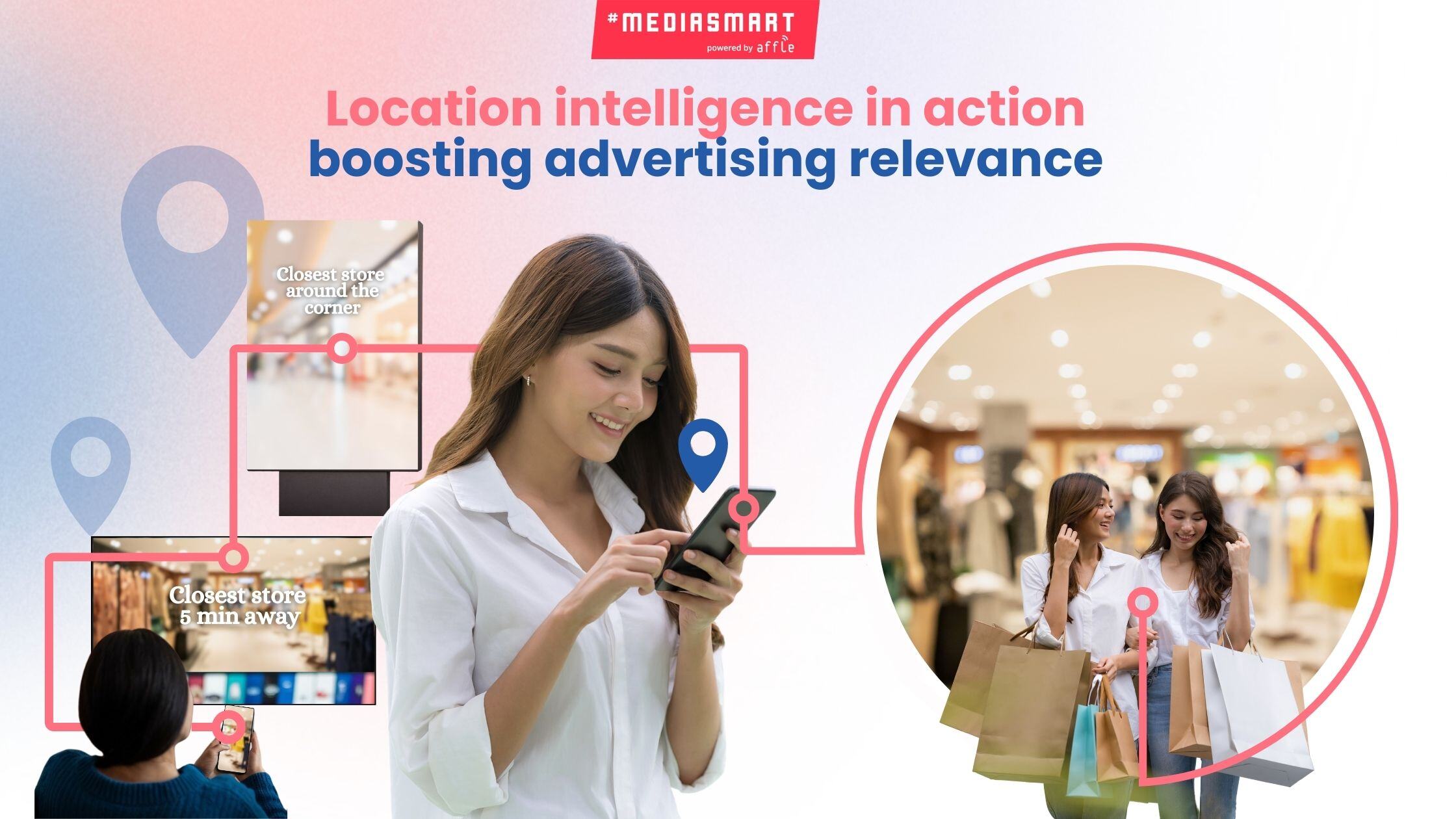Blog
Announcements, analysis and opinions on industry trends around the mobile programmatic world.

Subscribe now, and receive the latest programmatic content directly on your inbox!
Thank you for subscribing to our newsletter
With the location intelligence market expected to expand globally to over $60 billion by 2032[1], its insights will continue to provide brands with powerful tools to create more relevant and impactful advertising. Location intelligence keeps reshaping AdTech in real-time.
By integrating real-time geospatial data into programmatic advertising, brands can now deliver hyper-localized campaigns that engage consumers. For example, advertisers can trigger personalized offers when users enter specific areas, driving an 11% to 15% increase in online cart sizes for retailers using these strategies[2]. It also means being able to deliver dynamic content that responds to a user's real-world behavior, such as adjusting CTV ads based on a household’s neighborhood or altering DOOH displays based on placement.
From utilizing bid stream data for hyper-local targeting to creating seamless drive-to-store experiences, location intelligence is redefining how advertisers engage with consumers. This article explores the practical applications, challenges, and future potential of location intelligence in programmatic advertising, using a case study to highlight its impact.
Leveraging location data from the bid stream
Location data offers advertisers the ability to target users with unprecedented precision. During real-time bidding (RTB), using the OpenRTB protocol, the bid stream is where the magic happens. It’s all the data flying around: GPS coordinates, IP addresses, and other information letting advertisers hit users exactly where they are. Mobile users walking by a store? Hit them with a promo. CTV viewers? Serve them ads based on their neighborhood, city, or region. Geofencing or geolocating is about making ads land where and when they are relevant.

Use cases: How location intelligence enhances targeting precision
Bid stream location data allows mobile apps to trigger ads when users enter a specific zone—for instance when someone walks into a mall and receives a personalized offer on their smartphone. A survey of director-level marketers at global companies revealed that 96% saw positive ROI from localization efforts[6]. Location intelligence supercharges targeting precision by honing in on where users are in real time.
On Mobile, it’s all about proximity targeting and geofencing. Hitting someone with directions to your store when they’re just around the corner is immediate, practical, and gets people through the door. On CTV, it’s about connecting with neighborhoods, cities, or even regions. Imagine a global brand creating a localized message that speaks to viewers at home, making it feel personal. It’s all about using location to make ads smarter and more effective.
This works great when users are free, but what about when they are at work or less likely to engage with their devices? In those cases, location intelligence can still help. You can use it to build audiences for future targeting with solutions like Location-based audiences, ensuring the message reaches them when they are more likely to respond.
In the case of DOOH, the magic is in tailoring ads to the person walking by, making it relevant to them right then and there. Making physical and digital data work together to keep the messaging engaging across screens is the next logical step. The right tech partner can allow advertisers to reinforce DOOH ads by retargeting nearby foot traffic on mobile and CTV later. With Audience Sync technology devices around the billboard are gathered, enabling smooth retargeting across multiple screens at a later time for a cohesive ad experience.
Success story: Instant delivery, impeccable impact for Swiggy Instamart
Swiggy Instamart with Havas, used mediasmart’s advanced location intelligence to launch a personalized campaign across India. Tailored video ads in regional languages reached 20 million users, achieving 87% VTR and driving 178,000 app opens, with +87% being new users.
Winner of the Bronze award for Mobile Advertising Excellence in Programmatic Campaigns at the 2023 Mobexx Awards, as well the Best Use of Programmatic and Performance Marketing at the 2024 Indian Television Digital Media Excellence Awards, this localized campaign positioned Swiggy Instamart a key player in hassle-free grocery shopping.
Seamless experiences and Drive-to-store
Brands can use Mobile, CTV, and DOOH location data to target users based on proximity to retail locations, delivering real-time offers. Audience sync tech has DOOH ad viewers retargeted on other devices, creating a seamless experience that ensures users see relevant ads across various touchpoints. Location intelligence can engage consumers at the right moment and also measure foot traffic, providing valuable insights into campaign effectiveness.
Retail is here to stay. Despite the growth of e-commerce, 75% of Australian consumers still prefer shopping in-store[5], valuing the hands-on experience. Cross-screen attribution connects the entire consumer journey—right from someone seeing an ad on their phone or their CTV at home to walking into the store, thanks to mobile geolocation data. 
Drive-to-store uses real-time location data to connect digital ads with physical retail visits. How can advertisers tell if visits are from a campaign and not just regular foot traffic? By using incremental metrics, which measure the foot traffic driven specifically by the ads. They compare a control group (people who didn’t see the ad) to those who did, helping you track who came because of the campaign. It’s a smart, data-driven approach to bridge the gap between digital and physical interactions.
Location data ties it all together. Someone sees an ad on their CTV, heads to the store later, and that movement is tracked through the bidstream. It is not magic, it is Drive-to-store. Now advertisers know what worked and where to double down. It’s not just about throwing ads out there—it’s about spending smarter, focusing on places where people engage, and watching the results roll in across every screen.
Challenges and ethical considerations of using location data
We have established that location data is like the secret sauce for smarter ads. Mobile phones, CTVs, digital billboards—these things are giving advertisers all the intel they need to know where users are and serve them ads at the right moment. But there is a catch. Advertisers shouldn't just grab people’s data without telling them what is going on, right?
As location intelligence becomes more integrated, marketers must navigate stricter privacy regulations like GDPR, CCPA, or PIPEDA and updated frameworks like the Transparency & Consent Framework (TCF). In many countries, ensuring transparency and obtaining explicit user consent is not optional—it’s critical. Securing location data through proper anonymization and encryption is equally important, especially as Mobile apps, CTV platforms, and DOOH networks increasingly collect sensitive location data .
At the same time, advertisers face the challenge of dealing with inaccurate or spoofed location data. VPNs and location spoofing apps can easily manipulate Mobile data, while CTV and DOOH networks can suffer from incorrect disclosure. This hurts the effectiveness of campaigns. The solution lies in better data validation, ensuring advertisers work with trusted partners and employ more advanced techniques to keep their data accurate and reliable.
Looking ahead, the future of location intelligence in programmatic advertising is promising, with 5G, Artificial Intelligence (AI), and the Internet of Things (IoT) set to revolutionize how precise targeting can become. However, it’s vital to balance that personalization with privacy, ensuring that while location data helps improve ad relevance and cross-device attribution, user trust is always a priority. Offering a positive privacy experience can boost brand preference by 43%, according to the Privacy by Design study by the IAB, Google, and Ipsos[11]. Consent-based marketing, where advertisers use location data ethically and effectively, will make brands thrive in an increasingly privacy-conscious world.
The next frontier of location intelligence in programmatic ads
The future of location intelligence in programmatic advertising is set to be revolutionized by 5G, AI, and IoT technologies.
With 5G, data speeds will be up to 100 times faster than 4G LTE, enabling rapid data transfer, ultra-low latency, and enhanced connectivity[3]. This will significantly boost video marketing, personalization, voice search, and augmented reality, while also improving the accuracy and immediacy of location data for real-time, location-based marketing. Mobile devices will trigger ads based on hyper-local zones, down to which aisle a shopper is in. CTV can use regional geofencing, delivering ads specific to local communities, while audience building of foot traffic around DOOH will be better. And, as 5G expands, it will unlock new, unforeseen opportunities for brands to create more engaging and impactful digital content.
Artificial intelligence, which has been at the core of the programmatic industry since day one, is now stepping up with a dual mission: to enhance both the geospatial analysis and creative potential behind digital marketing. More precise location data means machine learning makes sharper, faster decisions, getting ads to the right people at the exact right time. No one likes wasted impressions. On the creative side, things get even more exciting. Pair Dynamic Creative Optimization (DCO) with Generative AI, and we will be crafting hyper-personalized ads—text, images, videos—that adjust on the fly based on where someone is, what the weather is like, or the content they are consuming. It’s personalization like never before. And the best part? We’re just scratching the surface. The future holds even smarter campaigns that won’t just follow trends, they will set them.
By the end of 2024, over 207 billion devices[4] are expected to be connected globally through smart cities, wearables, and public spaces. The Internet of Things will support a vast amount of real-time location data, enabling digital billboards and mobile ads to adjust dynamically to movement patterns and environmental conditions[7]. The combined power of 5G and IoT will definitively drive a new wave of personalized advertising experiences across screens.
Smart wrap up
Location intelligence is changing the game in programmatic advertising, letting brands connect digital ads with real-world actions. By using Mobile, CTV, and DOOH location data, brands can target users in real time, whether it’s sending personalized offers when someone is near a store or driving foot traffic with drive-to-store strategies.
With innovation driving faster and smarter insights, ads will be able to now adapt instantly to a user’s location, behavior, or even the weather. Marketers, now’s the time to harness the power of geospatial data to elevate your campaigns.
By leveraging location intelligence, you can deliver real-time, personalized ads creating seamless experiences. The future is all about sharper targeting and seamless, cross-device experiences that move people. Contact us to start making your campaigns more precise and impactful.
Sources
[1] Location Intelligence Market Size, Statistics Report 2024-2032 | GMI
[2] Unlocking Value with Location Intelligence | BCG
[3] 5G positioning: What you need to know | Ericsson
[4] 2024 IoT And Smart Device Trends | Forbes
[5] Towards Seamless Commerce | KPMG
[6] State of Localization report | DeepL
[7] How The Internet Of Things Will Drive Marketing Forward | Forbes
[8] CTV ad dollars are going to waste | eMarketer
[9] 5 key stats on ad waste: Fraud, MFAs, brand risks, and beyond | eMarketer
[10] AdTech Spend to Reach $43.5 Billion Globally by 2029 | Juniper Research
[11] Privacy by design: the benefits of putting people in control | Google, Ipsos & IAB Europe
[12] Location-based services, untold story 5G most important use cases
Topics: footfall, drive-to-store, Geolocation, hyperlocation, AdTech, AI in programmatic, location intelligence in advertising, drive-to-store strategies
%20(1).jpg)

